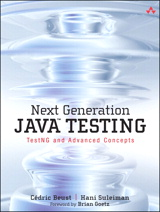作者:Jonathan Bach (James Bach 的兄弟,也是测试业的领头羊之一)
英文内容(预先提醒),PDF 格式
James Bach 关于此文的感想:
Is there a way to make exploratory testing just as accountable as pre-scripted testing without sacrificing the creativity of the exploratory approach? My brother Jonathan and I set this challenge for ourselves on a project in the summer of 2000. We wanted to give our client more than just a list of bugs and an invoice-- we wanted to provide an audit trail of our work along with meaningful productivity metrics. So, instead of counting test cases, we counted blocks of test design and execution time (test sessions) and recorded test results in a tagged text format that was then parsed to produce the metrics. This approached worked well, but proved to be quite challenging to manage, as Jonathan explains in the article. We think a lot of the difficulty is a by-product of the learning curve. We've stumbled into a new field here: test accounting. We're continuing to explore it.
由于搜索了一下这里还没有相关资料,所以与大家共享一下。
==============
探索性测试简介:
探索性测试(Exploratory Testing)
1、起源
探索性测试被认为最先由 Cem Kaner et. al. 在 Testing Computer Software 中定义,此后其他人(包括 James Bach)的工作使它得以普及。
为什么叫探索性测试,因为是一边测试一边探索。
2、定义:探索性测试是一个交互式的过程。在某种意义上讲是一个自由形式的测试过程,与人们说的游击式测试,直觉性测试有些相类似的地方。但探索性测试包含指定的任务、目标、交付物,所以与游击式测试又不同,而是形成了一个系统化的过程。
3、包含的五元素:
产品探索(Product Exploration)。探索和记录产品的目的和功能,数据类型,潜在的不稳定域。执行探索的能力依赖于你对技术的理解,你对产品信息和它潜在的用户的掌握,以及你花费了多少时间做这项工作。
测试设计(Test Design.)。决定操作、观察和评估产品的战略。
测试执行(Test Execution)。操作产品,观察产品的行为,使用这些信息构建产品如何运作的假定。
启发(Heuristics)。是帮助你决定要测试什么,如何测试的一系列指引或规则。
可检查的结果(Reviewable Results)。探索式测试是一个结果导向的过程。一旦你产生的交付物满足了特定的需求,测试就结束。对于测试测试结果是可以检查的、并能够与标准对比,这点尤为重要。
作为测试人员,你必须准备从任何角度向测试经理解释你的工作,并且展示它是怎么样满足已文档化的需求的。
4、优点:
1)在某些情况下,它的效率比脚本测试高出很多个数量级。
2)节省很多工作。尤其是前期的文档工作。
5、缺点
1)效率高,测试质量不一定好。要看性价比了。
2)可能适用于某些项目,如项目工期紧张,需求不明白、变更太频繁等。。
3)主要依赖于测试员的技能和知识来指导测试。人是最不可靠的。





 评论 (0)
评论 (0) 